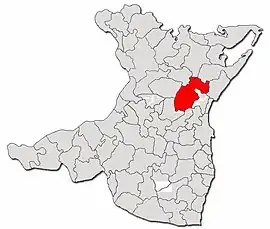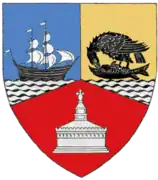Mihail Kogălniceanu, Constanța
Mihail Kogălniceanu (Romanian pronunciation: [mihaˈil koɡəlniˈtʃe̯anu] ⓘ) is a commune in Constanța County, Northern Dobruja, Romania, located 25 km (16 mi) northwest of Constanța proper. The commune includes three villages:
- Mihail Kogălniceanu - historical names: Kara Murat (Turkish: Karamurat), Bulgari (Bulgarian: Българи) and Regele Ferdinand
- Palazu Mic
- Piatra (historical name: Tașaul, Turkish: Taşağıl)
Mihail Kogălniceanu | |
|---|---|
 Location in Constanța County | |
 Mihail Kogălniceanu Location in Romania | |
| Coordinates: 44°22′0″N 28°27′30″E | |
| Country | Romania |
| County | Constanța |
| Subdivisions | Mihail Kogălniceanu, Palazu Mic, Piatra |
| Government | |
| • Mayor (2020–2024) | Ancuța-Daniela Belu[1] (PNL) |
| Area | 165.51 km2 (63.90 sq mi) |
| Population (2011-10-31)[2] | 9,978 |
| • Density | 60/km2 (160/sq mi) |
| Time zone | EET/EEST (UTC+2/+3) |
| Vehicle reg. | CT |
| Website | http://www.mk-primaria.ro |
The commune further includes two territorially distinct communities, Social Group Sibioara and Social Group Ceres, which are legally part of the village of Mihail Kogălniceanu. The Mihail Kogălniceanu International Airport is located nearby.
History
The village is situated on the site of a Roman settlement called Vicus Clementianus, discovered by the archaeologist Vasile Pârvan in 1913.
In 1651, the place was mentioned by the Ottoman traveler Evliya Çelebi as a Tatar settlement named Kara Murat ("Black Murat", after its founder).
In 1879-1880, after the incorporation of Northern Dobruja into Romania, the village started to be settled by Romanian shepherds from Transylvania (Mocani). In the 1930s it was renamed Ferdinand I, after King Ferdinand I of Romania. In 1948, with the advent of the communist regime, the commune was given its current name, after the Romanian politician Mihail Kogălniceanu.
Demographics
At the 2011 census, Mihail Kogălniceanu had 8,273 Romanians (84.95%), 3 Hungarians (0.03%), 246 Roma (2.53%), 3 Germans (0.03%), 33 Turks (0.34%), 419 Tatars (4.30%), 108 Aromanians (1.11%), 642 others (6.59%), and 12 with undeclared ethnicity (0.12%).[3]
Natives
- Adolph Bachmeier
- Dumitru Caraman
- Toma Enache (born 1970), film director[4]
- Stere Gulea
- Adrian Pllotschi
- Stere Sertov
 Town Hall
Town Hall Cultural Center
Cultural Center Clinic
Clinic
References
- "Results of the 2020 local elections". Central Electoral Bureau. Retrieved 15 June 2021.
- "Populaţia stabilă pe judeţe, municipii, oraşe şi localităti componenete la RPL_2011" (XLS). National Institute of Statistics.
- "Constanța County at the 2011 census" (PDF) (in Romanian). INSSE. February 2, 2012. Archived from the original (PDF) on March 24, 2012. Retrieved March 8, 2012.
- Godja, Dani (5 November 2019). "Regizorul Toma Enache ne povestește adevăruri pe care nu avem voie să le uităm" (in Romanian). Elita României.
External links
- "Romanians Eager for Long-Awaited Arrival of the Yanks", Kevin Sullivan, The Washington Post, February 6, 2006
